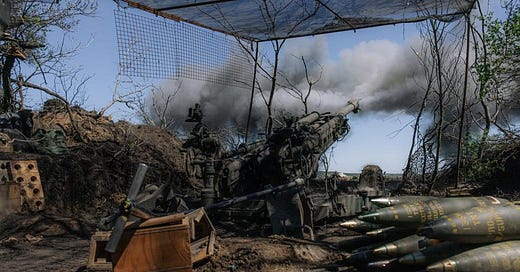Ukraine Might Be Getting $34 Billion In American Weapons—And Soon
That much money buys a lot of artillery and air-defenses

Six months after initially blocking a vote on further U.S. aid to Ukraine, the Russia-friendly speaker of the U.S. House of Representatives, Louisiana religious hardliner Mike Johnson, finally has relented to overwhelming pressure from the majority of the American electorate that wants the United States strongly to support Ukraine’s war of self-defense against Russian aggression.
That’s right, U.S. aid likely is coming, soon. Lots of it.
While Johnson hasn’t announced the details of the House proposal he said he would bring to a vote potentially this month, there’s a good chance it will mirror the spending package the U.S. Senate passed months ago—a package that includes $60 billion for Ukraine, $34 billion of which is for weapons. The rest pays for the training for Ukrainian troops as well as humanitarian aid and other non-military assistance.
To put into perspective how much weaponry $34 billion can buy, consider that—in the first 23 months of Russia’s wider war on Ukraine—the United States appropriated $45 billion for weapons for Ukraine.
Roughly half of that spending was in the form of direct commercial contracts the Pentagon negotiated, and paid for, on Ukraine’s behalf. The other half of the spending paid for new weapons for U.S. forces after the Pentagon donated their older weapons to Ukraine directly from U.S. stocks.
All that is to say, the aid that U.S. president Joe Biden, his Democratic allies in the U.S. Senate and U.S. House and millions of everyday Americans fought for, for six months, should keep Ukraine flush with arms for another year or more.
Expect the fresh aid to pay for a lot of radars, radio-jammers, drones, boats, armored vehicles and engineering equipment. Especially expect it to pay for artillery and air-defenses—and ammunition for both.
That should mean more 155-millimeter howitzers on top of the roughly 200 howitzers the previous funding paid for, more High-Mobility Artillery Rocket Systems on top of the previous 39 and more Patriot and National Advanced Surface-to-Air Missile System air-defenses batteries, adding to the single Patriot and 12 NASAMS Ukraine already has gotten from the United States.
And it should mean at least a million 155-millimeter artillery shells from the new ammo factory the U.S. Army built in Texas specifically to churn out shells for Ukraine. The Texas plant, as well as other new and expanded facilities that support ammo-production, depended on supplementary funding—and has been in financial limbo since Republicans cut off aid back in October.
With fresh funding, the Texas plant and a pair of similar plants in Pennsylvania can—likely within months—ramp up to producing 60,000 shells a month on their way to producing 100,000 shells a month within nine months. The Pennsylvania factories together produced just 15,000 shells a month before Russian widened its war on Ukraine in February 2022.
There’s no reason the majority of those 60,000-to-100,000 shells a months can’t go to Ukraine. This deluge of ammo will add to the hundreds of thousands of shells that the European Union is donating to Ukraine in the coming weeks and months—as well as to the one million shells a Czech-led consortium is donating, for starters.
As recently as February, Ukrainian artillery batteries were firing just 2,000 rounds a day, versus the 10,000 rounds a day Russian batteries could fire. This artillery gap is one of the main reasons Ukrainian brigades lately have been falling back—and a main reason Russian regiments and brigades have been advancing, albeit at enormous cost.
With U.S., E.U. and Czech shells—potentially at least 2.5 million of them through the end of the year—Ukrainian batteries should begin matching the Russian batteries’ rate of fire of 10,000 rounds a day. Considering that Ukrainian artillery tends to be more accurate than Russian artillery is, this means that—soon—Ukraine could have the artillery advantage ... for the first time in a year.
It’s hard to overstate how significantly this new firepower advantage could improve Ukraine’s fortunes. It’s equally hard to overstate how much Ukraine will benefit from additional air-defense batteries and missiles for these batteries.
The 90-mile Patriot is Ukraine’s best air-defense system, but it has just three batteries each originally with around a dozen launchers: Germany donated two batteries and the United States donated one.
That’s been enough to defend just two of Ukraine’s dozens of large cities—Kyiv and Odesa—from Russian missiles and drones while also arming one mobile air-defense unit that travels along the front line in order to ambush Russian warplanes.
The latter unit has wreaked havoc with Russian air force fighter regiments but recently lost two of its precious launchers and some crews to a Russian rocket attack.
The Ukrainian air force needs more Patriots—preferably many more. And since Lockheed Martin and its partners have been expanding production of radars, launchers and missiles in anticipation of a huge spike in demand, Ukraine probably already would have had the extra batteries and missiles, had Republicans approved further U.S. aid six months ago, when Biden first proposed it.
Better late than never. With, say, three more Patriot batteries, Ukraine could replace battlefield losses, defend Kharkiv and Dnipro and assign two batteries to mobile units: one each for the eastern and southern fronts. Adequately supplied with a few hundred missiles, an expanded Ukrainian Patriot force could end the missile and drone threat to Ukraine’s biggest cities and also blunt Russia’s massive air-power edge over the front line.
Assuming Speaker of the House Johnson honors his word and brings Ukraine aid to a vote this month, a lot of money and a lot of badly-needed weapons are about to arrive at the front line of Russia’s brutal war of national elimination. Ukraine may be just weeks away from getting much, much stronger.
Sources:
1. The New York Times: https://www.nytimes.com/2024/04/01/us/politics/mike-johnson-ukraine-aid.html
2. U.S. Senate: https://www.appropriations.senate.gov/imo/media/doc/emergency_national_security_supplemental_section-by-section.pdf
3. U.S. Defense Department: https://media.defense.gov/2024/Feb/01/2003386207/-1/-1/1/UKRAINE-INFOGRAPHIC-15-JAN-2024.PDF
4. U.S. Army: https://www.army.mil/article/271572/strengthened_army_industrial_base_doubles_artillery_production
5. Militarnyi: https://mil.in.ua/en/news/lockheed-martin-was-awarded-a-contract-for-the-production-of-pac-3-missiles/





